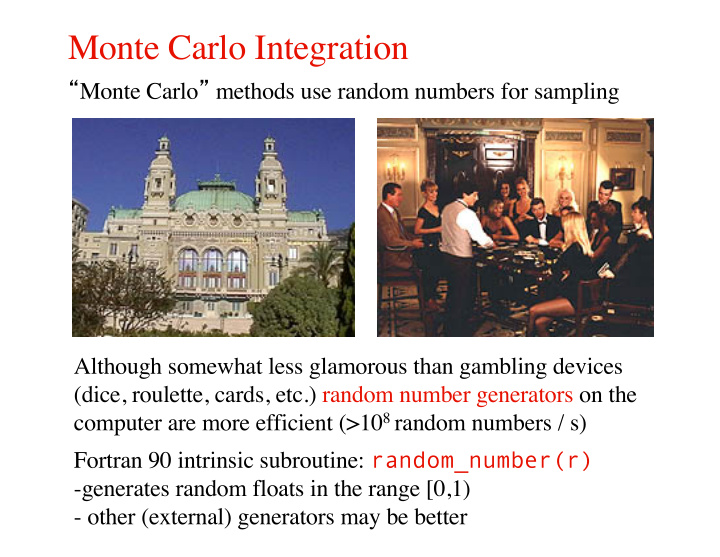



Monte Carlo Integration “ Monte Carlo ” methods use random numbers for sampling Although somewhat less glamorous than gambling devices (dice, roulette, cards, etc.) random number generators on the computer are more efficient (>10 8 random numbers / s) Fortran 90 intrinsic subroutine: random_number(r) -generates random floats in the range [0,1) - other (external) generators may be better
An integral can be written as an average: Estimate of average based on N random points Fortran 90 implementation: average=0.d0 do i=1,n call random_number(r) average=average+func(a+r*(b-a)) enddo average=average/n Fluctuations (statistical error; “ error bar ” ):
Time-scaling (number of ops) for D dimensional integration Numerical integration on regular mesh: Monte Carlo integration to desired accuracy (error = σ ): (D independent) Monte Carlo is more efficient for large D Example: Statistical mechanics of many-particle systems (liquids, gases,...) D = 3N (N = # of particles) Simple Monte Carlo integration problematic if integrand has sharp peaks (rarely visited); Use importance sampling methods First: Error analysis in simple Monte Carlo integration Ø carries over to importance sampling discussed later
Standard illustration: the area of a circle Example using random generator (function) ran(): do i=1,n x=2.d0*ran()-1.d0; y=2.d0*ran()-1.d0 if (x**2+y**2 < 1.d0) a=a+1.d0 Enddo A=4.d0*a/n Gives an estimate of 4 independent runs
Statistical errors ( “ error bars ” ) Calculation based on N points. What is the error? Consider M independent calculations (each with N points) Statistically independent averages Average Standard deviation M A = 1 � ¯ ¯ A i M i =1 But, we want the standard deviation of the average The M independent calculations are often referred to as “ bins ”
The standard deviation (error) has a well defined meaning if Ø the bin averages follow a Gaussian distribution Law of large numbers Ø Gaussian distribution approached for large N (points/bin) In the circle area calculation; binomial distribution: N=1 (A=0,1), N=2 (A=0,1/2, 1), N=3 (A=0,1/3,2/3,1),...
Let ’ s look at the distribution for N=1,...,100!
Program “ circle.f90 ” ; computing error bars do j=1,nbin sum=0.d0 do i=1,n call random_number(r) x2=(dble(r-0.5))**2 call random_number(r) y2=(dble(r-0.5))**2 if (x2+y2 <= 0.25d0) sum=sum+1.d0 enddo sum=4.d0*sum/dble(n) av=av+sum er=er+sum**2 write(*, ’ (A,I3,A,F11.6)') ’ Bin: ',j, ’ Result: ',sum enddo av=av/dble(nbin) er=er/dble(nbin) er=sqrt((er-av**2)/dble(nbin-1))
Monte Carlo integration less efficient if Ø the integrand has sharp peaks (visited infrequently) Example: Modified circle integration; singularity at r=0 Integrable if Distribution of r inside circle: Distribution of function values inside circle: d f Probability of point falling inside circle: 2 P ( f ) = (1 − π / 4) δ ( f ) + π α f − 1 − 2 / α Θ ( f − 1) 4
Distribution of average over N samples: � ∞ � ∞ P ( A ) = d f N · · · d f 1 P ( f N ) · · · P ( f 1 ) δ [ A − ( f 1 + · · · + f N ) /N ] 0 0 Monte Carlo calculation of P(A) for N=1000, • Still far from Gaussian distribution • Broad distribution implies large error bars • Bin size >> 1000 required to compute error bars reliably
What happens if we attempt to calculate a divergent integral? Example: Same integral as before with 3 independent runs • Erratic behavior seen • Arbitrarily large fluctuations upward • Well-defined distribution of A for finite N • Log-divergent typical value vs N •Average not defined (infinite) for N= ∞
Recommend
More recommend